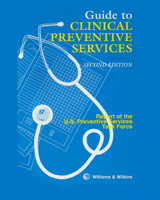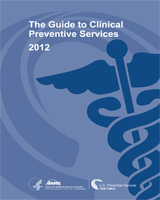NCBI Bookshelf. A service of the National Library of Medicine, National Institutes of Health.
US Preventive Services Task Force. Guide to Clinical Preventive Services: Report of the U.S. Preventive Services Task Force. 2nd edition. Baltimore (MD): Williams & Wilkins; 1996.
This publication is provided for historical reference only and the information may be out of date.

Guide to Clinical Preventive Services: Report of the U.S. Preventive Services Task Force. 2nd edition.
Show detailsWe are gratified by the response to the first edition of the U.S. Preventive Services Task Force Guide to Clinical Preventive Services. The Guide has become an established reference source for clinicians needing evidence-based recommendations on preventive services for managers and payers seeking information on preventive care and for students, trainees, and researchers interested in both the process and substance of preventive service guidelines.
This second edition of the Guide has been completely revised. The Task Force has reevaluated each preventive service and rewritten each chapter. There are 11 new chapters in the book, bringing the total number of topics evaluated to 70. Over 6,000 citations to the literature substantiate the recommendations.
As with the first edition, the Task Force has benefitted enormously from the contributions of others. We have continued our close working relationship with our partners to the north, the Canadian Task Force on the Periodic Health Examination. Representatives of the agencies of the U.S. Public Health Service have provided wise counsel representatives from the major primary care medical specialty societies have reviewed and commented on every chapter and hundreds of topic experts have graciously given their time to critique specific chapters. The Task Force immensely appreciates all of this assistance the final recommendations in the Guide, however, should be taken as those of the Task Force alone.
Given the revolutionary changes that are currently taking place in our health care delivery system, this edition comes out at a particularly opportune time. We know with ever-increasing certainty that health professionals can prevent many of the leading causes of death by using the proper interventions we know that all forms of health care are now being carefully scrutinized for their effectiveness and appropriateness and we know that managed care professionals, employers, and others are pursuing new agendas for quality in health care. The underlying philosophy of the Task Force fits the times perfectly: health professionals should recommend only those interventions for which there is convincing evidence that the benefits will outweigh the potential harms.
As before, the recommendations in the Guide are the beginning, not the end, of a process. The next step -- implementation -- is up to individual practitioners, systems of care, employers and payers, and legislative and regulatory bodies. We hope that these science-based preventive care recommendations will be helpful in all of their efforts to improve health care delivery and, ultimately, the health of the American people.
- HAROLD C. SOX, Jr., MD
- Chairman, U.S. Preventive Services Task Force
- Joseph M. Huber Professor and Chair Department of Medicine
- Dartmouth-Hitchcock Medical Center
- Lebanon, NH
- J. MICHAEL McGINNIS, MD
- Deputy Assistant Secretary for Health and Director, Office of Disease Prevention and Health Promotion
- U.S. Department of Health and Human Services
- Washington, DC
- Preface to the Second Edition - Guide to Clinical Preventive ServicesPreface to the Second Edition - Guide to Clinical Preventive Services
Your browsing activity is empty.
Activity recording is turned off.
See more...
